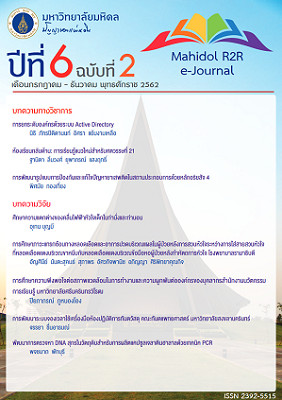ศึกษาความแตกต่างของคลื่นไฟฟ้าหัวใจเด็กในท่านั่งและท่านอน
DOI:
https://doi.org/10.14456/jmu.2019.12บทคัดย่อ
แม้ว่าท่านอนจะเป็นท่ามาตรฐานในการตรวจคลื่นไฟฟ้าหัวใจ (Electrocardiograph; ECG) แต่สำหรับวัยเด็กเล็กอายุที่อายุน้อยกว่า 5 ปีนั้น ส่วนใหญ่มักไม่ให้ความร่วมมือในการนอนตรวจ ซึ่งบ่อยครั้งจำเป็นจะต้องใช้ท่านั่งในการตรวจแทน จึงเกิดคำถามว่าท่านั่งที่ใช้ตรวจ ECG เด็กนั้นจะให้ผลเหมือนหรือแตกต่างกันกับท่านอนหรือไม่อย่างไร และจากการทบทวนงานวิจัยพบว่าผลงานที่มีการศึกษาเปรียบเทียบท่าทางที่ส่งผลต่อ ECG นั้นส่วนมากเป็นการศึกษาในผู้ป่วยวัยผู้ใหญ่ ส่วนในวัยเด็กนั้นยังมีน้อย ส่วนใหญ่มุ่งศึกษาประเด็น QTc เป็นหลัก จึงทำการศึกษาวิจัยแบบย้อนหลังเพื่อเปรียบเทียบความแตกต่างของ ECG ทั้งสองท่าทางขึ้นเพื่อนำผลที่ได้ไปใช้อธิบายและปรับปรุงกระบวนการให้บริการตรวจ ECG โดยศึกษาย้อนหลังจากการทบทวนผล ECG ในผู้ป่วยเด็กไทย อายุ 3 -11 ปี จำนวน 120 คู่ (240 leads) ที่ได้รับการตรวจทั้งสองท่าต่อเนื่องกันทันทีหรือห่างกันไม่เกิน 30 นาที ด้วยการนับจำนวนช่องของ P duration, PR interval, P voltage, QRS duration, QRS voltage, QT interval, T duration, T voltage นำค่าที่ได้ของทั้งสองท่าเปรียบเทียบความแตกต่างด้วยสถิติ Pair T-Test ผลการวิจัยพบว่า ECG เด็กที่ได้จากทั้งสองท่าจะให้ค่าส่วนใหญ่ไม่ต่างกัน ยกเว้นค่า QRS voltage ของ Chest leads ในท่านอนเท่านั้นที่จะให้ค่าสูงกว่าอย่างมีนัยสำคัญทางสถิติ (P value < 0.05) โดยสูงกว่าประมาณ 3 ช่อง (0.3 mV) ซึ่งค่า QRS voltage จะมีความสำคัญในแง่การบอก Cardiac morphology โดยเฉพาะภาวะ Ventricular hypertrophy
เอกสารอ้างอิง
2. DAVEY, P. J. C. S. (1999). Influence of posture and handgrip on the QT interval in left ventricular hypertrophy and in chronic heart failure. 96(4), 403-407.
3. Eldridge, J., Richley, D., Baxter, S., Blackman, S., Breen, C., Brown, C.,Rees, E. (2014). Recording a standard 12-lead electrocardiogram. An approved methodology by the Society of Cardiological Science and Technology (SCST). Clinical guidelines by consensus.
4. Hancock, E. W., Deal, B. J., Mirvis, D. M., Okin, P., Kligfield, P., & Gettes, L. S. J. J. o. t. A. C. o. C. (2009). AHA/ACCF/HRS Recommendations for the Standardization and Interpretation of the Electrocardiogram: Part V: electrocardiogram changes associated with cardiac chamber hypertrophy a scientific statement from the American Heart Association Electrocardiography and Arrhythmias Committee, Council on Clinical Cardiology; the American College of Cardiology Foundation; and the Heart Rhythm Society Endorsed by the International Society for Computerized Electrocardiology. 53(11), 992-1002.
5. Khare, S., & Chawala, A. J. N. J. o. C. (2016). Effect of change in body position on resting electrocardiogram in young healthy adults. 13(2), 125.
6. Kubo, Y., Murakami, S., Otsuka, K., Shiga, T., Irie, S., & Kasanuki, H. J. J. o. A. (2005). Postural Change-associated Alterations in QT/QTc Intervals on Electrocardiograms. 21(5), 528-535.
7. Madias, J. E. J. J. o. e. (2006). Comparability of the standing and supine standard electrocardiograms and standing sitting and supine stress electrocardiograms. 39(2), 142-149.
8. Markendorf, S., Lüscher, T. F., Gerds-Li, J.-H., Schönrath, F., & Schmied, C. M. J. C. j. (2018). Clinical impact of repolarization changes in supine versus upright body position. 25(5), 589-594.
9. Rautaharju, P. M., Surawicz, B., & Gettes, L. S. J. J. o. t. A. C. o. C. (2009). AHA/ACCF/HRS recommendations for the standardization and interpretation of the electrocardiogram: part IV: the ST segment, T and U waves, and the QT interval a scientific statement from the American Heart Association Electrocardiography and Arrhythmias Committee, Council on Clinical Cardiology; the American College of Cardiology Foundation; and the Heart Rhythm Society Endorsed by the International Society for Computerized Electrocardiology. 53(11), 982-991.
10. Surawicz, B., Childers, R., Deal, B. J., & Gettes, L. S. J. J. o. t. A. C. o. C. (2009). AHA/ACCF/HRS recommendations for the standardization and interpretation of the electrocardiogram: part III: intraventricular conduction disturbances a scientific statement from the American Heart Association Electrocardiography and Arrhythmias Committee, Council on Clinical Cardiology; the American College of Cardiology Foundation; and the Heart Rhythm Society endorsed by the International Society for Computerized Electrocardiology. 53(11), 976-981.
11. To, A., & Officer, A. J. M. (2010). Adult & Paediatric Resting Electrocardiography (ECG) Cardiac Sciences. 6.
ดาวน์โหลด
เผยแพร่แล้ว
ฉบับ
ประเภทบทความ
สัญญาอนุญาต




